Top image is of female forced laborers wearing “OST” (Ostarbeiter) badges are liberated from a camp near Łódź, January 1945, Łódź Poland, United States Holocaust Memorial Museum, courtesy of an unknown Russian archive, 19317.
"It was a beautiful afternoon the day we left Krakow. Our homeland, abused by the occupation said goodbye to us with a sunny day. The monotonous clatter of the train wheels painfully reminded us that it was taking us away as slaves.”
– Maria Hosajowa, a former Polish forced laborer
During World War II, Nazi authorities condemned millions of Belarussians, Estonians, Latvians, Lithuanians, Poles, Russians, Ukrainians, and Yugoslavs to forced labor as part of an aggressive campaign to conquer and establish a colony in Eastern Europe. Nazi forced labor policy in occupied Eastern Europe was a product of Hitler’s colonial ambitions, Nazi racial ideology, and economic necessity resulting from the war with the Soviet Union.
Nazi racial ideology, which denigrated Slavs and placed them slightly above Jews and Roma in the Nazi racial hierarchy, impacted almost every aspect of the forced labor experience for Eastern Europeans. This can be seen in the registration process, transport to Germany, working and housing conditions, and food rationing. Although conditions varied significantly throughout labor camps in Germany compared to Western European laborers, Eastern Europeans often faced discrimination, worked and lived in punitive conditions, and experienced mental and emotional trauma.
Registration and Transport to Germany
After Fritz Sauckel, the Nazi Plenipotentiary General for Labor, established quotas for conscripting men and women to work in Germany, Nazi authorities increasingly relied on violence to involuntarily “recruit” millions of men and women from Eastern Europe. Immediately following conscription, a Nazi medical team gave all Eastern European forced laborers a physical examination and, since Nazi racist thinking assumed all Slavic people to be disease-ridden, they were also given a decontamination shower prior to being transferred to a transit camp to await deployment.
Transit camps were often located in liquidated POW camps, abandoned factories, warehouses, or former schools near local German labor offices. There were numerous transit camps established along border towns in the major cities of the Occupied Eastern Territories, in the so-called General Government in parts of occupied Poland, and within Germany itself. Since the majority of forced laborers came from Poland and the Soviet Union, many transit camps, such as those located in Łódź, Przemyśl, and Poznań, were equipped with enough staff to process and register thousands of forced laborers per day.
-

All Eastern European forced laborers were assigned Arbeiterbücher für Ausländer, which was their official worker documentation. “Arbeiterbücher für Ausländer belonging to the author’s grandparents, Maria Swerden and Ivan Popowycz,” Popowycz family documentation, photo taken by author in August 2017.
-

All Eastern European forced laborers were assigned Arbeiterbücher für Ausländer, which was their official worker documentation. “Arbeiterbücher für Ausländer belonging to the author’s grandparents, Maria Swerden and Ivan Popowycz,” Popowycz family documentation, photo taken by author in August 2017.
Which transit camp forced laborers passed through depended on where they lived, but according to historian Sophie Hodorowicz Knab, all transit camps shared several features:
“All had this in common: they were often filthy, unheated, without running water, without suitable numbers of toilets or lacking basic sanitary equipment altogether, and with the appropriate cots or beds to accommodate the thousands of individuals who passed through every day.”
After a short stay in a transit camp, Nazi labor officials made a transport list, lined individuals up, and marched them to the nearest train station. Then, Nazi guards packed anywhere from 60 to 80 men, women, and children into extremely overcrowded cargo wagons, usually with no place to sit or lay down. Inna Kulagina, a former Ukrainian forced laborer, described her week-long journey to Germany in the fall of 1942:
“It was a terrible feeling, because we were being transported like animals, everyone in one space. It was already October, it was cold. We slept with our clothes on. We would wake up and no one could wash, everything was dirty. In the truest sense we were [treated] like livestock.”
As Kulagina testified, during the winter occupants froze, but in the summer months the stifling heat caused heat stroke and dehydration. During the trip, transports were often shunted off main railways to allow trains carrying German troops to the Eastern Front to pass. Even though trains stopped frequently to pick up additional forced laborers throughout the day, passengers were only allowed to disembark the train once at night. In some cases, Nazi labor officials provided a small ration of bread but, more often than not, Eastern Europeans had to rely on any food they brought with them for the journey to Germany.
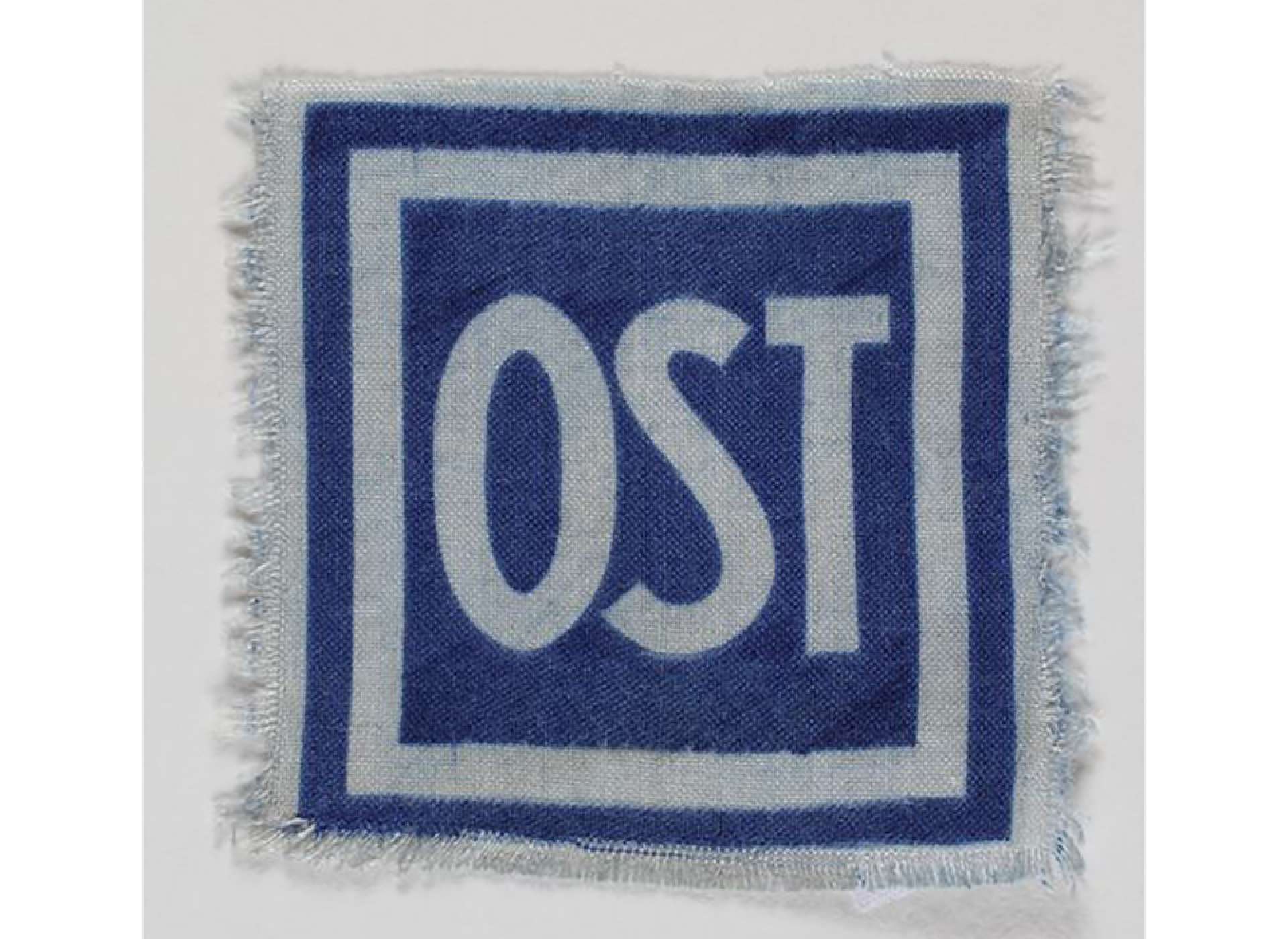
Unused OST badge that would have been worn by a forced laborer to identify them as an Ostarbeiter Worker from the East, usually Russian or Ukrainian, deported to work in Nazi Germany. “Unused OST badge,” 1942-1945, United States Holocaust Memorial Museum, 2005.506.4.
To keep spirits up, many sang patriotic songs, conversed, or prayed together. Others plotted ways to escape, but there were few opportunities since each boxcar was heavily guarded. A German labor official also accompanied each train, with copies of the transport list to hand over to the district labor office in Germany. If a person escaped and did not arrive at their designated reception center, German authorities sent copies of the escapee’s documentation back to the local labor office in Eastern Europe, and the matter was turned over to the SS and local police.
“At the border…the train slowed down and a few individuals jumped off. They were shot at unrelentingly. Were they successful in their escape or were they left on the banks of the railroad tracks?”
– Anonymous former Polish forced laborer
The terrible conditions on train transports to Germany created a heavy atmosphere since the only information provided to forced laborers by Nazi labor officials was that they were being sent to work in Germany. Rarely did they know their final destination, what kind of work they would be assigned, or how long they would be forced to stay abroad.
Job Assignment and Working Conditions
Upon arrival in Germany, Eastern European workers were given an additional medical examination and placed in another transit camp where they waited for their work assignment. It was also during this time that women were given a second “racial inspection” to determined their eligibly for the Nazi housemaid program.
This program employed Eastern European forced laborers to work in German homes taking care of children, performing household chores, and assisting in maintaining small farms. In order to prohibit injecting the German race with any undesirable racial elements, only Eastern Europeans with distinctive German physical characteristics were assigned to work in German households.
The Deutsche Arbeitsfront, the Nazi organization responsible for forced labor policy, originally attempted to assign Eastern European forced laborer jobs based on education, past employment, and language skills. However, as the war continued and the Wehrmacht faced setbacks on the Eastern Front, the agency delegated jobs based on war needs. As a result, the majority of Eastern European forced laborers worked in the industrial sector—in textile mills, sugar refineries, ammunition factories, airplane and railcar manufacturing, chemical plants, rubber factories, and coal mines.
Work in the industrial sector usually began with a wakeup call between 4:00 and 5:00 a.m., after which the factory guard (werkschutz), typically an elderly man too old for military service, escorted the forced laborers to the factory grounds. Although they often worked with Germans and foreign laborers from Western Europe, Nazi regulations required Western and Eastern workers to be kept physically separate whenever possible. This ensured that Eastern Europeans were assigned the more dangerous and labor-intensive jobs. As a result, many Eastern Europeans had to work in confined spaces with contaminated air and with caustic, harmful materials.
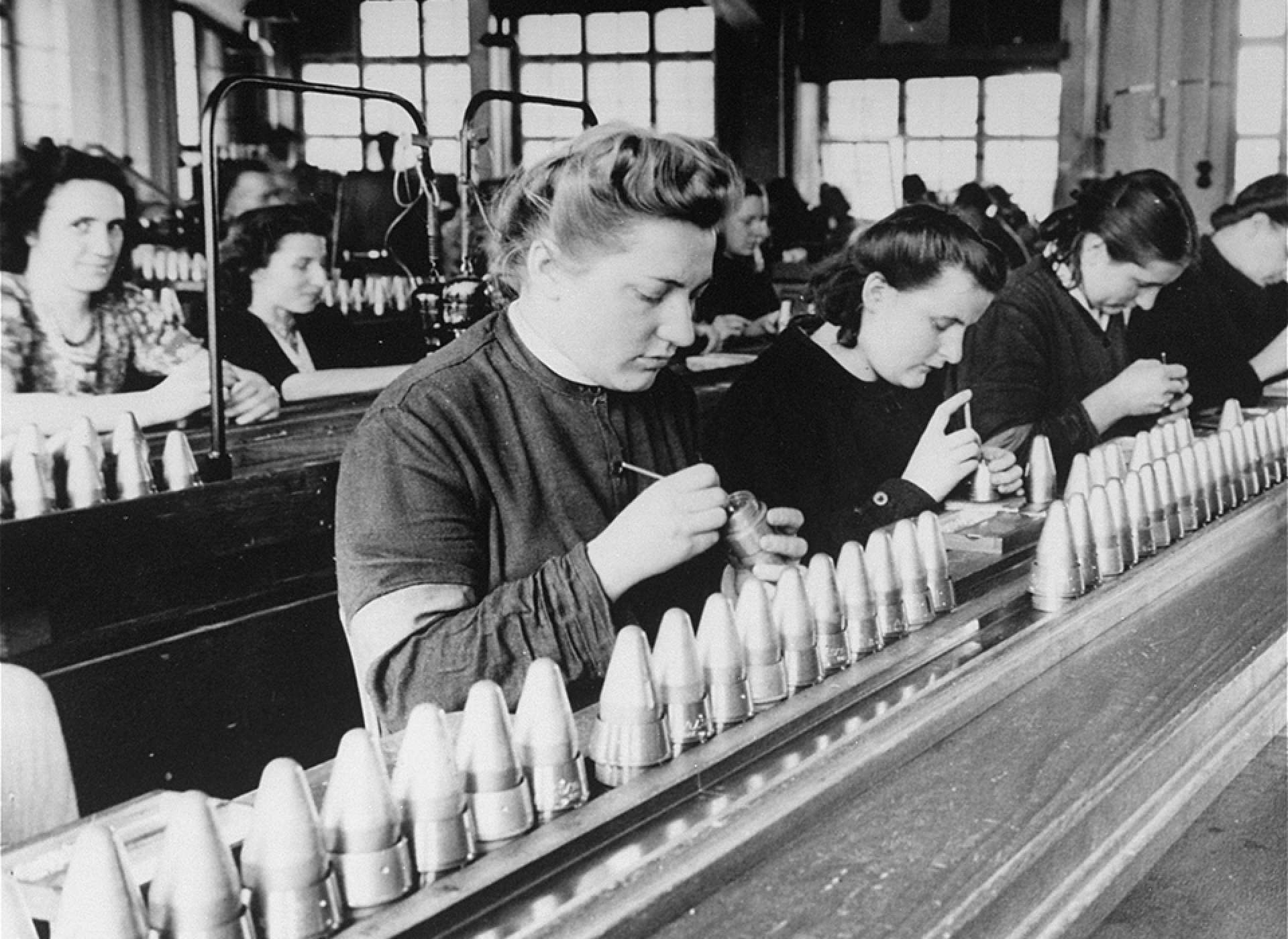
Female foreign workers in Stadelheim work in a factory owned by the AGFA camera company, May 1943, Germany, United States Holocaust Memorial Museum, courtesy of National Archives, 09047.
Forced laborers from Eastern Europe also worked on small and large farms where they tended and plowed fields, harvested grain and vegetables, milked cows, fed cattle, mucked livestock stalls, and cut weeds. The personalized circumstances of working on a small family farm usually led to more humane treatment by employers and higher food rations, but on large agricultural estates, forced laborers were under the constant eye of an armed foreman. Janina Tuminska, a teenager when she worked on a farm for two years in East Prussia, remembered what this was like:
“Not once could you straighten up, look up to the sky or along the road…your nose always had to be to the ground, your hands in constant motion…I had so many jobs to attend to. My only rest was washing the dishes and peeling the potatoes. And in winter evenings, when the hard work was finished early, I had to knit with stiff and aching fingers.”
The working conditions in Germany varied significantly between industrial and agricultural sectors, and the character of German factory managers and farm owners. Nonetheless, in both economic spheres, Nazi labor policy mandated 12-hour workdays, six or seven days a week. Although forced laborers were paid, Eastern European wages were about 50 to 85 percent less than what German and Western European workers received.
Eastern European forced laborers also had to pay a social compensation tax to the state as well as fees for food, shelter, and clothing. Even if a small sum remained, Eastern Europeans could not buy anything since they were not allowed in German stores and almost everything was sold on ration cards.
Housing
In May 1942, Sauckel issued a decree ordering that “as far as it is possible, separate camps are to be provided for the members of different nations.” The combination of Nazi racial ideology and Sauckel’s instructions ensured that housing facilities kept Western and Eastern Europeans strictly segregated. In larger housing complexes—such as the camp barracks in Mainz—Poles, Ukrainians, and Russians resided in separately assigned buildings, whereas in smaller camps national groups were divided into separate rooms with their own washrooms, sinks, and toilets.
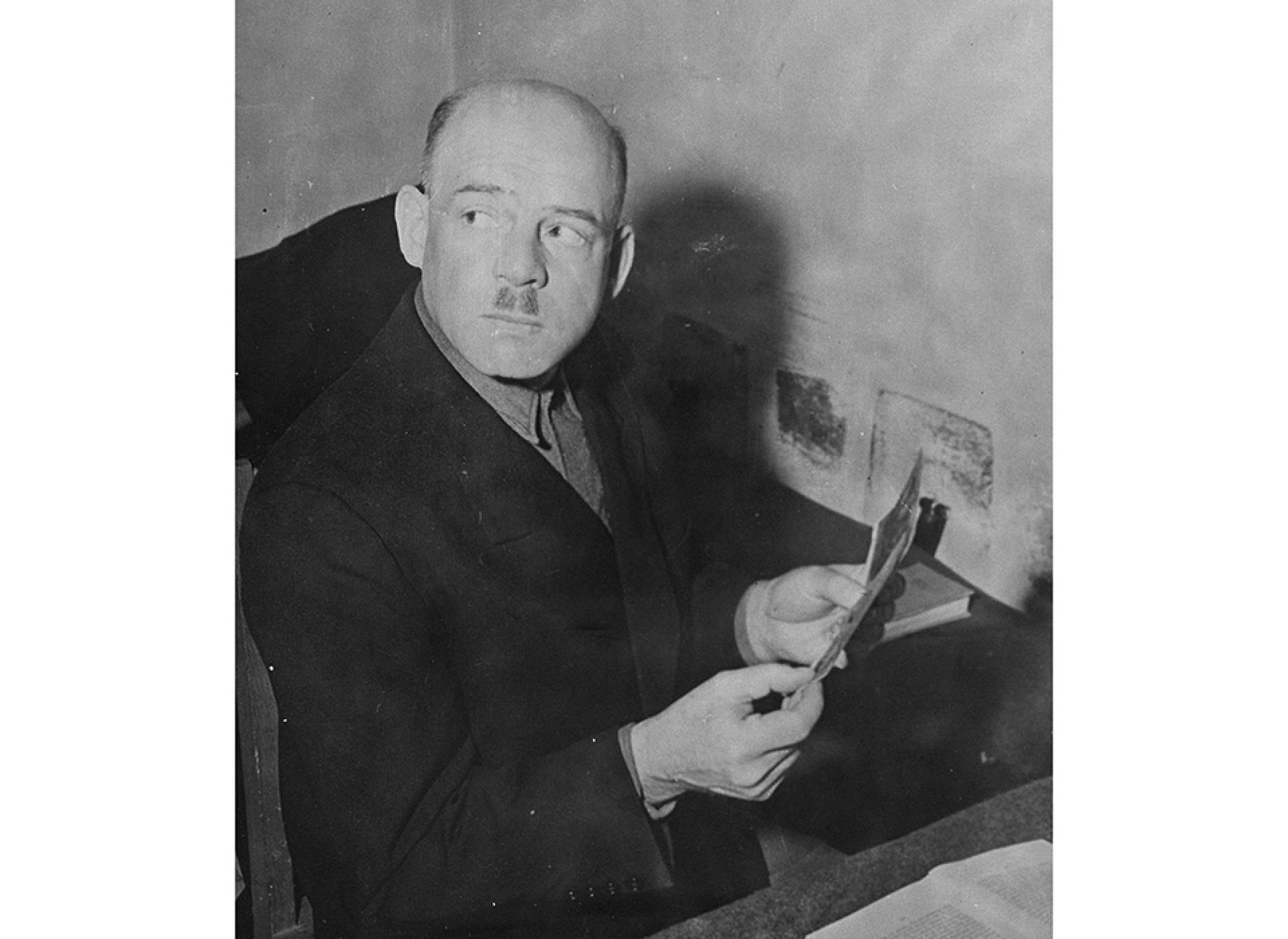
Fritz Sauckel, the former Plenipotentiary General for Labor, in his prison cell at the International Military Tribunal trial of war criminals at Nuremberg, November 20, 1945-October 1, 1946, Nuremberg, United States Holocaust Memorial Museum, courtesy of National Archives, 14132.
Camp barracks in industrial centers varied in size, but most have been described by former forced laborers as poorly constructed, surrounded with barbed wire, and heavily guarded. The barracks were typically equipped with one small stove, a limited number of washrooms and toilets, beds filled with sawdust mattresses, and few blankets. Kazimier K., a former Polish forced laborer who worked at an industrial firm in Berlin, described the primitive conditions in her testimony:
“There were twenty girls in our room. There were ten bunk beds, wooden ones…the bunk beds were made of narrow boards as wide as the palm of a hand…the mattresses stuffed with straw…two thin blankets…there weren’t any sheets just the blankets…there was one table, a coke stove and two benches…those were our furnishings…hangers for our clothes was [sic] a stick found on the road and a piece of string…that’s how we lived.”
In general, those working on farms lived in healthier accommodations. Some German farmers, in spite of Nazi labor regulations, arranged decent living situations for Eastern Europeans working on their farms. Even those who were housed in cramped and poorly lit rooms in attics, converted clothes closets, or basements, had more privacy and adequate furnishings.
Regardless of the size of camp barracks, the difference in housing accommodations for Eastern and Western Europeans was a significant detail that most former forced laborers cite. Housing for Western Europeans were similar to those provided for German workers, which were less crowded, outfitted with proper bedding, furnished with tables and chairs, and equipped with a sufficient number of bathrooms.
Food Rations
Perhaps the most difficult aspect of the forced labor experience for Eastern Europeans was the meager food rations that often led to severe hunger, malnutrition, and outright starvation. Similar to the housing situation, the amount of food forced laborers received depended on whether one was employed in the industrial or agricultural sector, with the latter having access to better food or more options to supplement minimal rations.
Janin Tuminska, who worked on a small German farm, described what a typical meal for farm workers consisted of in her oral history:
“It wasn’t the worst. We ate what they [Germans] ate only at a different table, in the kitchen. There were four to five meals daily depending on the work and the season. For the first and second breakfast—coffee and bread with fat (lard, margarine, sometimes butter) or marmalade. An afternoon supplement if one was doing heavy work also the same. For supper—hot potatoes topped with some kind of fat, milk, or barley soup, sweetened.”
In contrast, Eastern Europeans working in factories received one cup of coffee or tea, 200-300 grams of bread, and one or two cups of watery cabbage soup per day. These rations, however, largely depended on what food was available, and as the war continued, food rations often decreased. For instance, in the Gutehoffnungshütte iron and steel plant in Düsseldorf, Eastern European workers only received three slices of bread and one serving of watery soup made from carrots or turnips each day.
In other areas, Eastern European forced laborers received small amounts of potatoes, beets, or spinach, but as Julia Alexandrow, a former Ukrainian forced laborer noted in her memoir, “occasionally we had to pick bugs…sometimes fat green caterpillars like worms out of our ‘lunch,’ but we ate it anyway…it was all there was.” Poor food rations led some factory workers to volunteer on farms after hours since they were paid with extra food such as milk, bread, and butter.
In April 1942, following the influx of Eastern workers into Germany, the Nazi administration decreased food rations for German civilians, German workers, and foreign workers. Consequently, Eastern European workers often faced complications from malnutrition.
For example, in the Middledeutsche Motorenwerke plant in Leipzig, an average of 12 percent of forced laborers missed work due to undernourishment after the new regulations were put in place. According to the camp physician at the Krupp Steel factory in Essen, forced laborers collapsed on the floor from hunger and many complained of dizziness. Larissa Kotyeva remembered that in one instance she was sick from not eating enough and her manager “rebuked her for misbehavior” and took away her food rations for a week as a form of punishment.
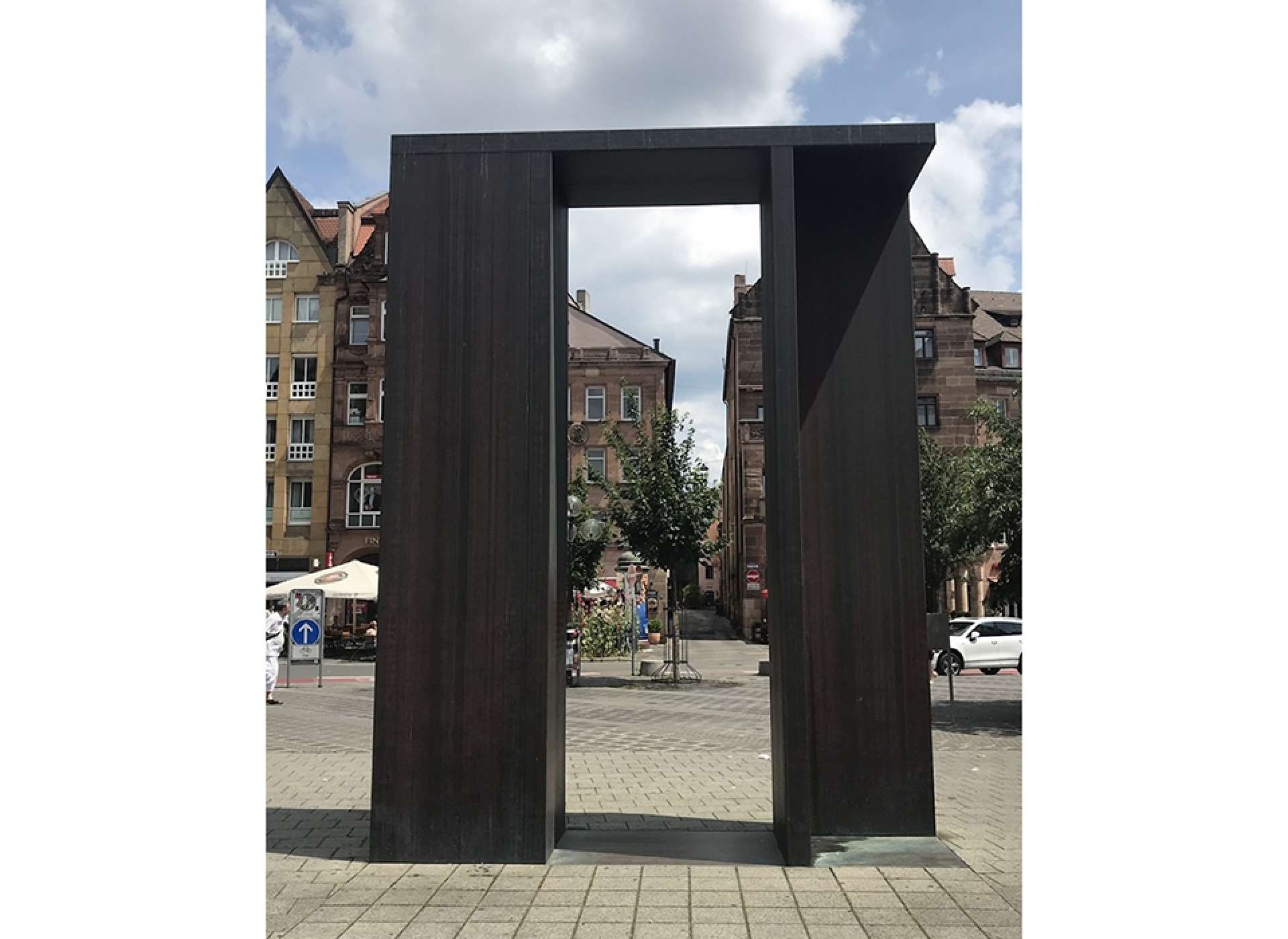
Memorial to all forced laborers located in Nuremberg, Germany, photo taken by author in June 2019.
In comparison, the Reich Minister of Food and Agriculture established a standard weekly ration for German and Western Europeans in the spring of 1942, which consisted of 450 grams of meat, 225 grams of fats, 2,800 grams of bread (400 grams per day), and 5,350 grams of potatoes (750 grams per day). While these rations decreased over the course of the war, German and Western European workers received more food than Eastern Europeans.
Nazi labor officials also gave German and Western Europeans extra rations for performing “heavy” work and for working overtime. They also were allowed to receive packages from the Red Cross. Wanda S., a Ukrainian forced laborer working at a factory in Essen, vividly recounted the disparity in food distribution in an interview stating, “There were other camps for French, Italians, and Slovaks. The French and Italians received packages from the Red Cross. To this day, I’ll never forget how they ate before our eyes.”
Free Time
Initially, Nazi foreign labor regulations prohibited Eastern European workers from leaving camp barracks except to go to work, and banned them from interacting with Western European or German workers. According to Sauckel’s May 1942 regulations, “The use of freetime [sic] of the foreign workers and workers within and outside of the camps is to be made within the framework of the given war-limited possibilities and according to the peculiar qualities of the workers.” These vague instructions allowed industrial managers and farm owners considerable leeway in regulating time off.
In 1942, industrial workers were given time off for good behavior and “exceptional productivity,” although Eastern Europeans were only allowed to leave the camp barracks in small groups and had to be accompanied by a German supervisor. In contrast, those employed on farms typically had Saturday or Sunday afternoons off and, in many cases, were encouraged to attend church services.
At all times, Eastern Europeans had to wear a badge designating their nationality on their right chest to keep them separate from the German populace. Men and women from the areas of prewar Poland and the Nazi-occupied General Government had to wear a yellow badge with a purple “P” to identify them as Polish citizens. Those from prewar Soviet territory were assigned a blue, rectangular badge with the letters “OST” written in white.
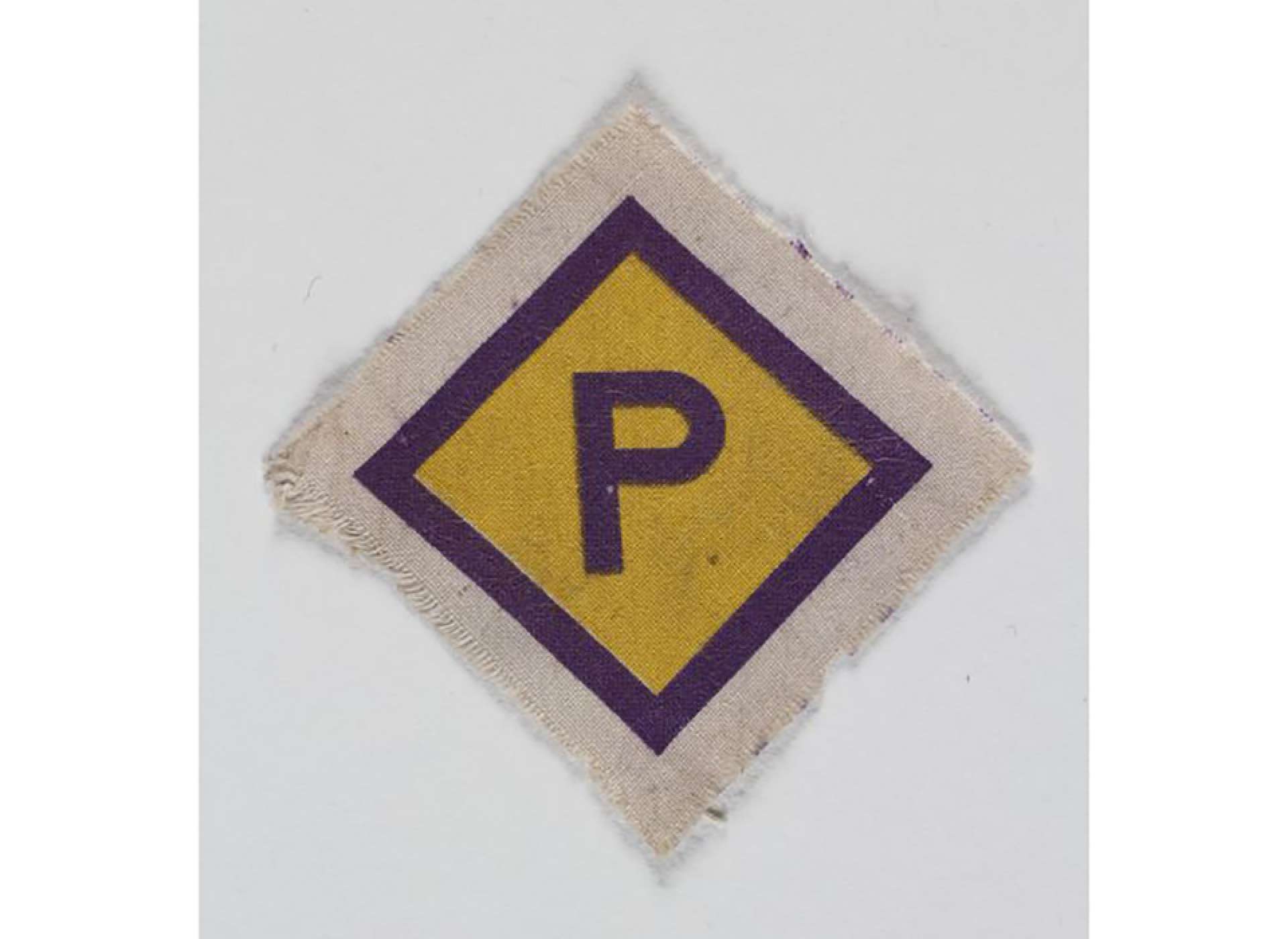
Unused forced labor badge, yellow with a purple P and a purple border, that would be worn to identify a Polish forced laborer in Nazi Germany, circa 1940-1945, United States Holocaust Memorial Museum, 2005.506.5.
By 1943, however, the German Labor Front granted all forced laborers one day off per week and the right to leave camp barracks without a chaperone. This was as long as they adhered to a curfew and wore their assigned national badge. In July 1943, in an attempt to increase productivity, DAF also organized individual meeting houses for separate national groups in cities that employed a large number of foreign workers. These meeting places often held dances and concerts and created opportunities for forced laborers to practice cultural traditions, celebrate their own national and religious holidays, and share news of events back home.
Remembering the Forced Labor Experience
The experience of forced labor for Belarussians, Estonians, Lithuanians, Latvians, Poles, Russians, and Yugoslavs was completely overshadowed by Nazi racial ideology, which created a tightly controlled and closed system of subjugation. According to Knab, “Any infraction of the rules resulted in police or Gestapo involvement, with the looming threat of removal to a concentration camp or prison.”
Living in a state of constant supervision and surveillance left psychological scars on former forced laborers. Many recall mental suffering, bad nerves, and periods of extreme sorrow and grief while employed in Germany during the war. When asked in an interview to describe how she remembered the war, Halyna Jachno stated, “The war was a severe blow of fate for the whole people. You just had to get through it. I suffered along with everyone.”
Despite living in a world of hardship and poverty, Eastern Europeans relied on each other and found ways to exert their own agency, if not outright resistance to Nazi racial policy and forced labor regulations. Feigning illness, decorating barracks with photographs from home, organizing prohibited religious celebrations, stealing extra food rations from factory kitchens, or refusing to wear their national badge when leaving the camp all served as small ways in which Eastern Europeans resisted Nazi authority.
After the war ended, remembering the forced labor experience created a feeling of solidarity between Eastern Europeans who remained in Germany and those who returned home. Therefore, memories of World War II and the suffering it caused served as a collective memory among many different Eastern European national groups, which not only bonded them, but also became a significant marker of national identity in postwar displaced persons camps and diaspora communities.
Jennifer Popowycz, PhD
Jennifer Popowycz, PhD is the Leventhal Research Fellow at The National WWII Museum. Her research focuses on the Eastern Front and Nazi occupation policies in Eastern Europe in World War II.
Cite this article:
MLA Citation:
APA Citation:
Chicago Style Citation:
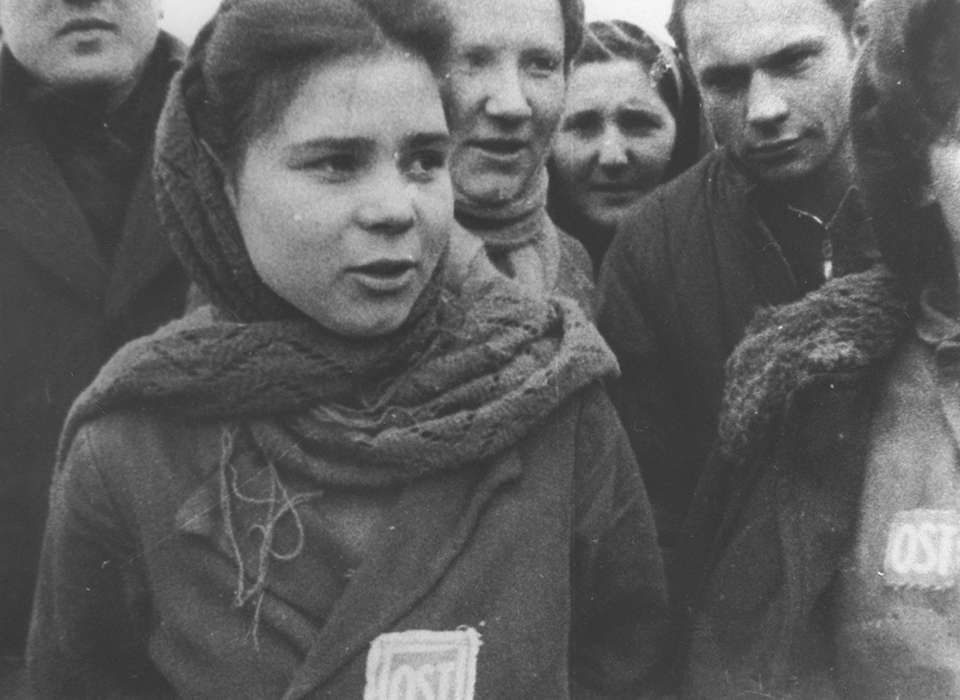
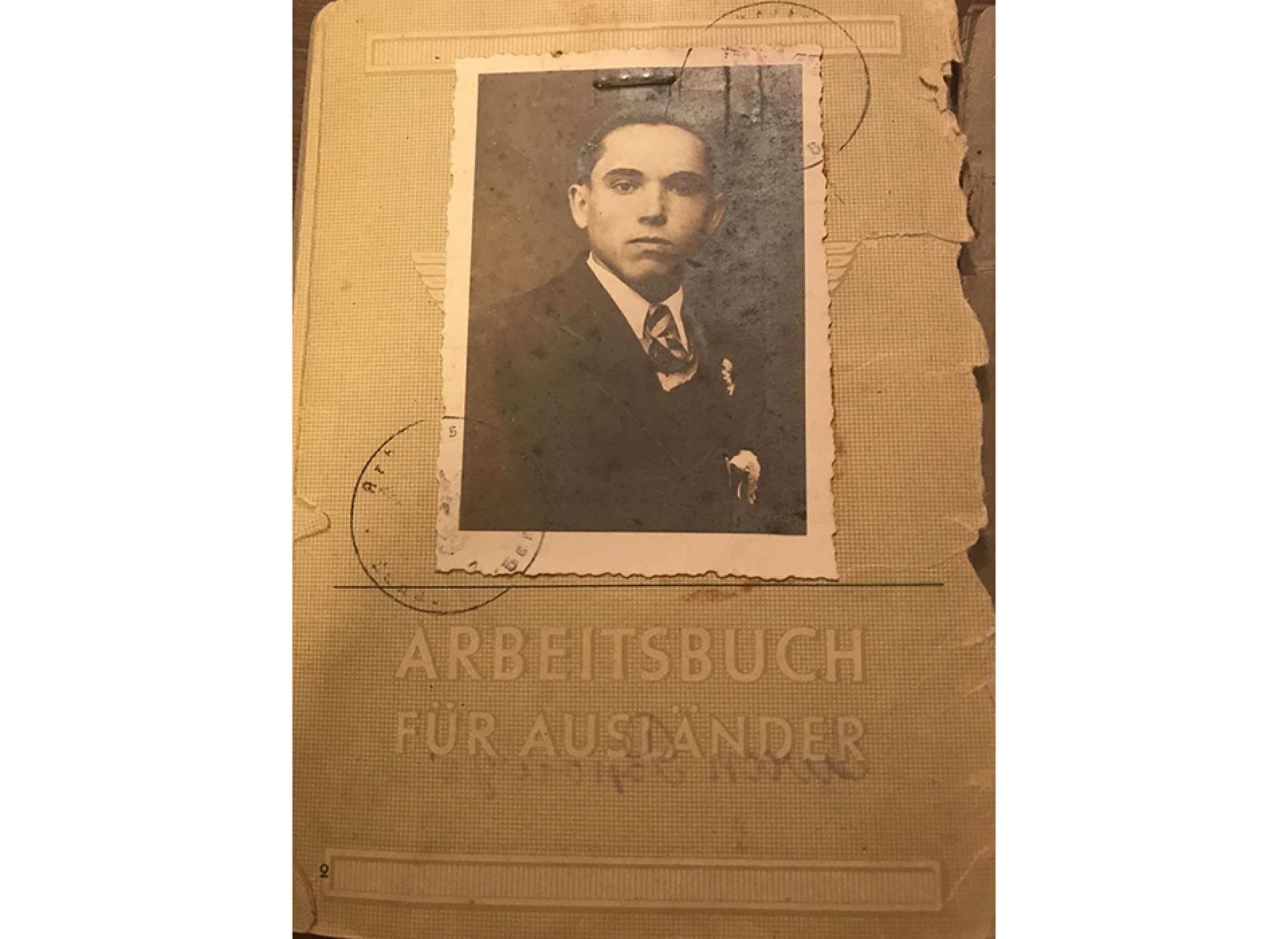
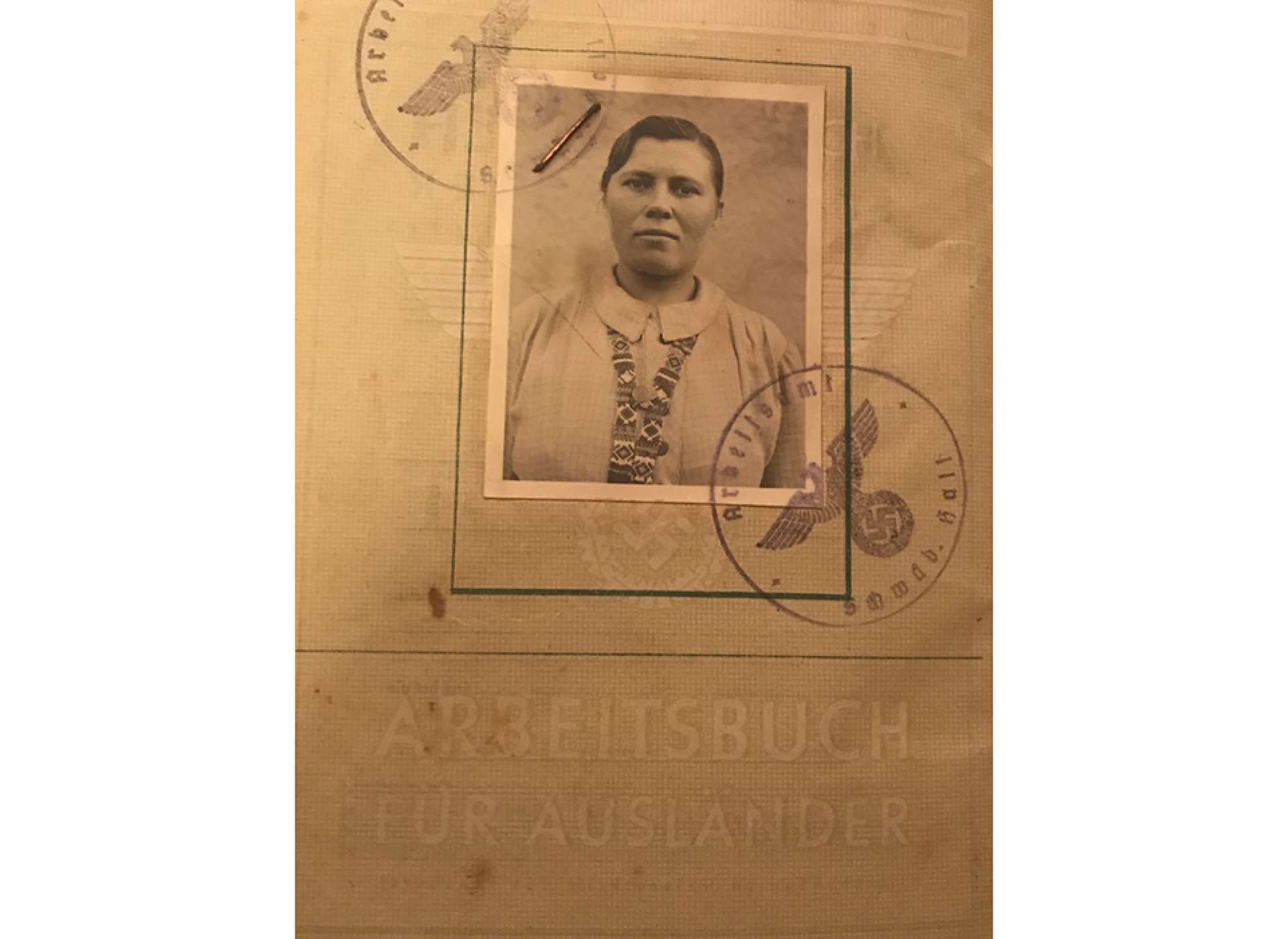

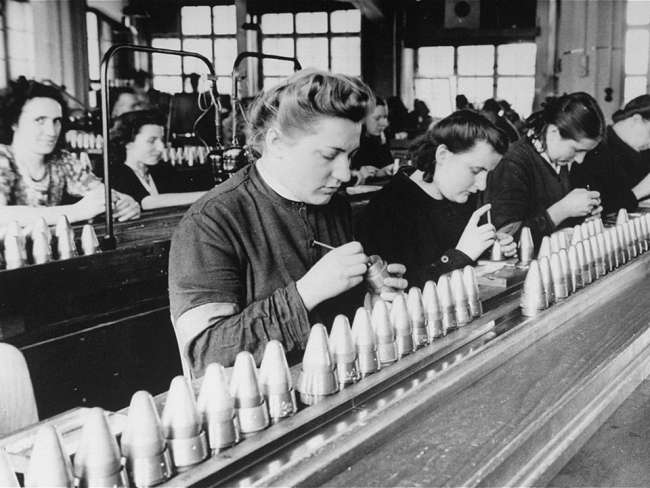

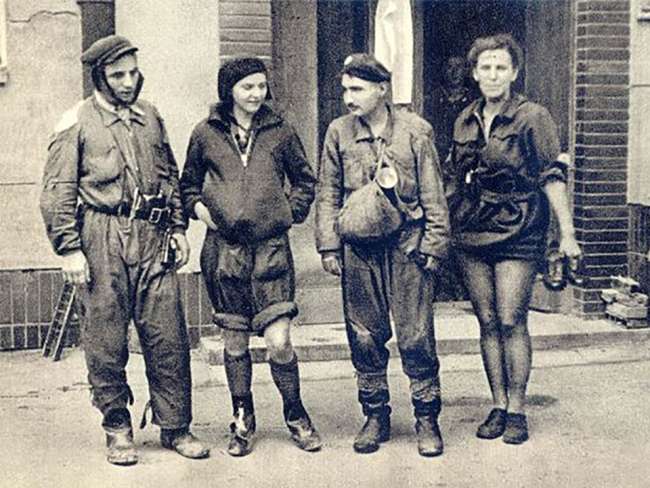
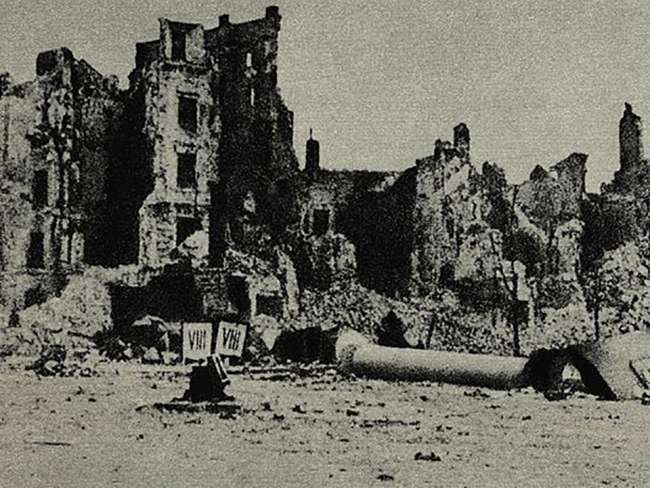



![Max Fuchs, New York City cantor, sings as Rabbi Sydney [sic] Lefkowitz, Richmond, VA, conducts the first Jewish services from Germany.](/sites/default/files/styles/max_650x650/public/2025-10/image1.jpg)



